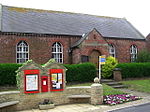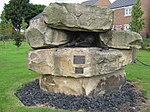Hardwick Hall Hotel, Sedgefield
Hotels in County DurhamSedgefield

Hardwick Hall in Sedgefield, County Durham is a building of historical significance and is listed on the English Heritage Register. A major part of it was built in the late 1700s but it is possible that some of it dates from about 1634. It was the residence for many notable people for two centuries. It is now a hotel which provides accommodation and restaurant services and caters for special events particularly weddings.
Excerpt from the Wikipedia article Hardwick Hall Hotel, Sedgefield (License: CC BY-SA 3.0, Authors, Images).Hardwick Hall Hotel, Sedgefield
Grand Terrace,
Geographical coordinates (GPS) Address External links Nearby Places Show on map
Geographical coordinates (GPS)
| Latitude | Longitude |
|---|---|
| N 54.657916666667 ° | E -1.4655277777778 ° |
Address
Hardwick Hall Hotel
Grand Terrace
TS21 2EH
England, United Kingdom
Open on Google Maps





